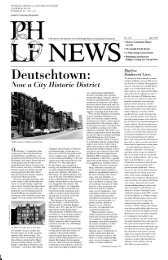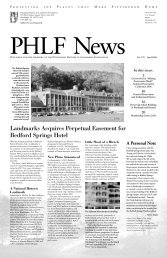Download - Pittsburgh History & Landmarks Foundation
Download - Pittsburgh History & Landmarks Foundation
Download - Pittsburgh History & Landmarks Foundation
You also want an ePaper? Increase the reach of your titles
YUMPU automatically turns print PDFs into web optimized ePapers that Google loves.
2 PHLF News February 2010 ADVOCACY COMMUNITY REVITALIZATION EASEMENTS EDUCATION & RESEARCH FARM & LANDSCAPE PRESERVATION<br />
The Red Lion Restaurant, Second Avenue,<br />
in the Elizabeth Borough Historic District<br />
Parkway Steps, Chalfant<br />
Second Presbyterian Church of Braddock<br />
20 Historic Landmark Plaques Awarded<br />
Hot Metal Bridge and Monongahela<br />
Connecting Bridge, South Side<br />
McCook House, Shadyside<br />
Woodland Hills Academy, Turtle Creek<br />
Notz House, West Mifflin<br />
The Historic Plaque Designation<br />
Committee of the <strong>Pittsburgh</strong> <strong>History</strong><br />
& <strong>Landmarks</strong> <strong>Foundation</strong>, chaired by<br />
Trustee Richard M. Scaife, awarded<br />
20 plaques during its meeting on<br />
October 22, 2009, recognizing some<br />
55 structures, including the Allegheny<br />
County Fairgrounds, two historic districts,<br />
two bridges, and a handsome set of<br />
city steps. The 20 “Historic Landmark”<br />
sites are (in chronological order):<br />
1. Miller-Zorn-Bush House, 503 Hill<br />
Street, Sewickley (c. 1840–1850);<br />
2. Elizabeth Borough Historic District,<br />
Second Avenue, Elizabeth<br />
(c. 1850–1930);<br />
3. Tarentum Historic District, Fifth<br />
Avenue, Tarentum (1886–1920);<br />
4. Second Presbyterian Church of<br />
Braddock (now Calvary A.M.E.<br />
Church of Braddock), 441 Sixth<br />
Street, Braddock (1892);<br />
5. Kopp Glass, Inc., 2108 Palmer Street,<br />
Swissvale (1899);<br />
6. Sweeney Hotel and Saloon (later<br />
Natrona Bank), 46–48 Chestnut<br />
Street, Natrona (1900);<br />
7. Hot Metal Bridge (1900) &<br />
Monongahela Connecting Bridge<br />
(1904; now Hot Metal Street Bridge),<br />
Oakland/South Side;<br />
8. St. Mary’s Episcopal Church (now<br />
Triumph The Church and Kingdom<br />
of God in Christ), 618 Lillie Avenue,<br />
Braddock (Charles M. Bartberger,<br />
architect, 1901);<br />
9. Munhall Volunteer Fire Company #1,<br />
1300 Martha Street, Munhall (1902);<br />
10. Superintendent Henry J. Davis<br />
House, U.S. Steel Clairton Works,<br />
556 Mitchell Street, Clairton<br />
(c. 1903–1910);<br />
11. The Crescent Apartment Building,<br />
738 Rebecca Avenue, Wilkinsburg<br />
(c. 1904), see page 12;<br />
12. Willis F. McCook House (1907)<br />
and Mrs. Edgar McCook Reed<br />
House (1905), now Mansions<br />
on Fifth, 5105 Fifth Avenue and<br />
925 Amberson Avenue, Shadyside<br />
(Carpenter & Crocker, architects);<br />
13. Watson Memorial Presbyterian<br />
Church (now Riverview United<br />
Presbyterian Church), 3505<br />
Perrysville Avenue, Perry North<br />
(Allison & Allison, architects, 1907);<br />
14. Regal Shoe Company (Alden &<br />
Harlow, architects, 1908–1909),<br />
and 489–491 Market Street,<br />
Downtown (1870s), now Market<br />
at Fifth (see page 3);<br />
15. Masonic Building, 322 Center<br />
Avenue, Verona (Charles F. Reed &<br />
Bros. Lumber Co., builder, 1909);<br />
16. Turtle Creek High School,<br />
now Woodland Hills Academy<br />
(see page 21), 126 Monroeville<br />
Avenue, Turtle Creek (George H.<br />
Schwan, architect, 1917–1919);<br />
17. Allegheny County Fairgrounds,<br />
South Park (1927–1934);<br />
18. Parkway Steps, between Parkway<br />
Avenue and North Avenue, Chalfant<br />
(Works Progress Administration,<br />
1936);<br />
19. Hulda and Louise Notz House,<br />
120 Lutz Lane, West Mifflin<br />
(Cornelia Brierly, architect, 1940);<br />
20. Woman’s Club of Mt. Lebanon,<br />
750 Hollycrest Drive, Mt. Lebanon<br />
(Ingham & Boyd, architects, 1940).<br />
Beginning this year, the committee<br />
will consider plaque applications from<br />
counties surrounding Allegheny, especially<br />
if the applicant site has some<br />
connection to the Greater <strong>Pittsburgh</strong><br />
region, e.g., property owned by a<br />
leading <strong>Pittsburgh</strong>er or the work of a<br />
distinguished <strong>Pittsburgh</strong> architect.<br />
Since <strong>Landmarks</strong> has extended its area<br />
of operation to within a 250-mile radius<br />
of <strong>Pittsburgh</strong>, it is logical to extend the<br />
reach of the plaque program also.<br />
The <strong>Pittsburgh</strong> <strong>History</strong> & <strong>Landmarks</strong><br />
<strong>Foundation</strong> created the Historic<br />
Landmark Plaque program in 1968 to<br />
identify architecturally significant structures<br />
and designed landscapes throughout<br />
Allegheny County. An Historic<br />
Landmark Plaque does not protect a<br />
building from alteration or demolition.<br />
To date, 546 plaques have been<br />
awarded to significant buildings,<br />
districts, landscapes, and structures<br />
throughout Allegheny County that are<br />
50 years old or more.<br />
For further information, visit<br />
www.phlf.org or contact Frank Stroker,<br />
program administrator: frank@phlf.org;<br />
412-471-5808, ext. 525.<br />
The Stables, South Park








